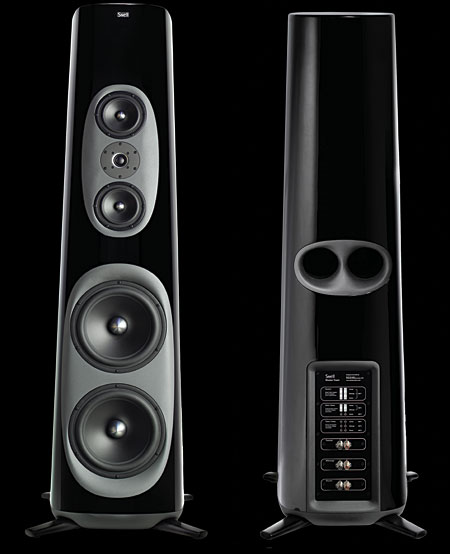
Fiberglass is used in the secondary side chambers these chambers attenuate the lower frequency output from the rear slot, which results in a generally flat frequency output over its effective range, at about 5 dB below the front, on-axis output. All of the midrange enclosure contains fiber filling, mostly polyester and some fiberglass, with densities varying from 1.2 to 2.1 lb/ft3 depending on location and material. Sound waves travel down the tapered TL, wrap around the diffuser/deflector into secondary tapered chambers to the sides of the box, then around the back of the diffuser and out the back of the cabinet through a vertical slot.

The exit end of this tapered TL coincides with the apex of a triangular-shaped diffuser/deflector. "The rather unique midrange enclosure uses a short, tapered TL, having a ¼-wavelength resonant frequency of ~400 Hz, to raise the falling lower-end response of the Neo8. Here's a link to an innovative midrange TL: Construction info on my winning MWAF speakers, the Amaroso (long) - Techtalk Speaker Building, Audio, Video Discussion Forum I guess you could just glue the smaller ones but I like a belt and braces approach for the heavier ones. That's the only messy and time consuming bit. Most people will have their own ideas about what's best for them and their skill set. or use wires and those screws with hooks or "eyes" at the top then tie them to the baffle etc. A wooden annulus increase the various bonding ares and strength etc. Then you need to glue them to the baffle with a lot of silastic etc. Then simply place them upside down and rotate them on the concrete/cement until they are "sanded" to a uniform and flush surface (easier than it sounds). If the casting is not completely flat on the top rim take them outside and find a concrete path. There ARE issues in fixing them to the baffle.

They even have a hole "pre-drilled" for wires! (May benefit from damping with body seal etc.haven't tried that yet.) They come in a variety of sizes. Most are circular and tapered so the standing wave issues are minimized. They have a number of advantages for a mid enclosure. Several times I have used terracotta flower pots. An enclosure lined with Tufflex is remarkably dead - significantly more effective than any other insulation materials I've tried, particularly better than polyfill pillow stuffing!

There are dramatic differences, both measurable and audible, to different damping materials to be used inside the mid's enclosure - I have not found a sorce to replenish my favored material which is a natural fiber padding that was used making furniture called "Tufflex". While a main purpose of the enclosure on a midrange is to isolate the back wave from the listener as much as possible, I think if a standing wave frequency is within the passband of the midrange it could be excited to a significantly higher SPL at that particular frequency than the reflected backwaves at various other frequencies - think of a tube resonator on a marimba for example? Though, if you were to put a midrange on an enclosure with no damping materials I think the level of the reflected sound coming back out through the cone will be both significant and negative. P.S.: I myself am a friend of no enclosure behind the mid driver. These are said to be very sensible for mass coupling. Be aware though that asymmetrical walls will not affect standing waves, the only cure here is to move them out of the used frequency band by minimizing the cave behind the cone.īe careful with damping material if you use a high efficiency midrange with a very thin, lightweight cone.
#TWEETER MIDRANGE SPEAKER ENCLOSURE DESIGN DRIVER#
Make sure it keeps a safe distance from the frequency band where the mid driver is used.Īdditionally, a small, asymmetrical (as Henkjan stated already) enclosure is to be preferred to minimize unwanted effects standing waves. What should not be ignored is the frequency of fb in the planned enclosure. So the Q in the vicinity of fb is of no interest and can be ignored. Different to woofers midranges are never used near their resonance frequency, but usually at least one octave above that - preferrably even higher. As far as I know midranges are not to be treated like small woofers.


 0 kommentar(er)
0 kommentar(er)
